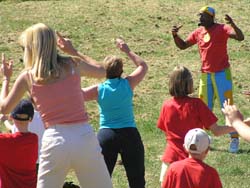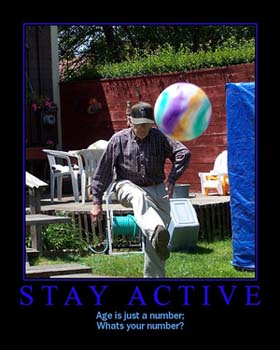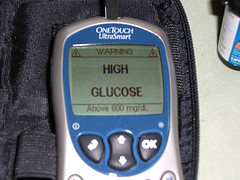Life Skills Development/Unit One/Wellness and Self Care (Fitness)/Lesson
Contents
What is physical fitness?
A state of well being that allows a person to perform daily activities with vigour, reduces the risk of health problems relating to lack of exercise, and is a sufficient fitness base to provide energy for daily participation in recreational physical activities and for handling emergencies
What types of exercise are there?
Aerobic Exercise
Aerobic exercise increases your heart rate, works your muscles, and raises your breathing rate. For most people, it is best to aim for a total of about 30 minutes a day, at least 5 days a week. If you haven't been very active recently, you can start out with 5 or 10 minutes a day and work up to more time each week. Or split up your activity for the day - try a brisk 10-minute walk after each meal. If you are trying to lose weight, you may want to exercise more than 30 minutes a day. Here are some examples of aerobic exercise:
- A brisk walk (outside or inside on a treadmill)
- Dancing
- A low-impact aerobics class
- Swimming or water aerobic exercises
- Ice-skating or roller-skating
- Tennis
- Riding a stationary bicycle indoors
Strength Training
Strength training, done several times a week, helps build strong bones and muscles and makes everyday chores like carrying groceries easier for you. With more muscle, you burn more calories, even at rest. Here are some ways to do it:
- Join a class to do strength training with weights, elastic bands, or plastic tubes
- Lift light weights at home
Flexibility Exercises
Flexibility exercises, also called stretching, help keep your joints flexible and reduce your chances of injury during other activities. Gentle stretching for 5 to 10 minutes helps your body warm up and get ready for aerobic activities such as walking or swimming. Your health care team can provide information on how to stretch.
Being Active Throughout the Day
In addition to formal exercise, there are many opportunities to be active throughout the day. Being active helps burns calories. The more you move around, the more energy you will have. These strategies can help you increase your activity level:
- Walk instead of drive whenever possible
- Take the stairs instead of the elevator
- Work in the garden, rake leaves, or do some housecleaning every day
- Park at the far end of the shopping centre lot and walk to the store
What are the specific advantages of exercise?
Longevity and Aging
Exercise, even after age 50, can add healthy and active years to one's life. Studies continue to show that it is never too late to start exercising and that even small improvements in physical fitness can significantly lower the risk of death. Simply walking regularly can prolong life in the elderly.
Moderately fit people, even if they smoke or have high blood pressure, have a lower mortality rate than the least fit. Resistance training is important for the elderly; because it is the only form of exercise that can slow and even reverse the decline in muscle mass, bone density, and strength. Adding workouts that focus on speed and agility may be even more protective for older people. Flexibility exercises help reduce the stiffness and loss of balance that accompanies aging.
Diabetes
Diabetes, particularly type 2, is reaching epidemic proportions throughout the world as more and more cultures adopt Western dietary habits. Aerobic exercise is proving to have significant and particular benefits for people with both Type 1 and Type 2 diabetes; it increases sensitivity to insulin, lowers blood pressure, improves cholesterol levels, and decreases body fat. Regular exercise, even of moderate intensity, improves insulin sensitivity. In fact, studies of older people who engage in regular, moderate, aerobic exercise (e.g., brisk walking, biking) lower their risk for diabetes even if they do not lose weight. Anyone on insulin or who has complications from diabetes must take special precautions before embarking on a workout program.
Effects on Colds and Flu
Although offering no evidence of improved immunity from exercise, one study reported that people who exercised as little as once a week in employee fitness programs averaged nearly five fewer sick days annually than those who did not participate in such programs. The immediate effect of exercise on the immune system is uncertain. High-intensity or endurance exercises might actually suppress the immune system while they are performed. For instance, some highly trained athletes report being susceptible to colds after strenuous events. A recent study suggested that in people who already have colds, exercise has no effect on the illness -- severity or duration of the infection. People should avoid strenuous physical activity when they have high fevers or widespread viral illnesses, however.
Pregnancy
Healthy women with normal pregnancies should exercise at least three times a week, being careful to warm up, cool down, and drink plenty of liquids. Many prenatal callisthenics programs are available. Experts advise, in general, that when exercising, the expectant mother's pulse rate should not exceed 70% to 75% of the maximum heart rate or more than 150 beats per minute. Fit women who have exercised regularly before pregnancy, however, may work out more intensively as long as no discomfort occurs. According to a new study, vigorous exercise may improve the chances for a timely delivery. Overly strenuous exercise during pregnancy is not advocated, however, for women who did not exercise intensely before becoming pregnant. And all pregnant women should avoid high-impact, jerky, and jarring exercises, such as aerobic dancing, which can weaken the pelvic floor muscles that support the uterus. During exercise, women should monitor their temperature to avoid overheating -- a side effect that can damage the foetus. (Note: No pregnant women should use hot tubs or steam baths, which can cause foetal damage and miscarriage.) Swimming may be the best option for most pregnant women. It involves no impact, overheating is unlikely, and swimming face down promotes optimum blood flow to the uterus. Walking is also highly beneficial. To strengthen pelvic muscles, women should perform Kegel exercises at least 6 times a day, which involve contracting the muscles around the vagina and urethra for 3 seconds 12 to 15 times in a row
How does the song parallel to having unhealthy life style?
“Sizzla”
Rise this morning
Give thanks for life
A new day for you to try
Yet nothing you’re doing
Contributing to life
Yuh (Skylark) as the day pass you by
Soon you’ll be complaining
That things not right
How could it be
When nothing you apply
You’ve been playing
My oh my
Play and no work make Jack a dull boy.
1. Discuss and explain a fitness definition and the different levels of fitness attainable. If necessary, use additional information. 2. Discuss how they intend to maintain their personal level of fitness.
| Goal | Strategy/Procedure | Desired Outcome | Time Frame | |
|---|---|---|---|---|
| Weight Management |
Unit summary
In this unit you learned about the importance of exercise and a fitness routine that is in keeping with your fitness level. You learnt the benefits of remaining fit, especially in reverence to the prevalent life style diseases that plague our society. You are now equipped to take positive action and to inform others.
Checklists of Performance Task
1. Fitness plan to maintain / improve their fitness level.
| RUBRIC of performance criteria | V. Well Done | Well Done | OK | Not Ok- Will redo by …. | |
|---|---|---|---|---|---|
| RUBRIC of performance criteria | Time Check | ||||
| From To | From To | From To | From To | From To | |
| I am engaging in the types of exercise I selected in my fitness plan as itemised below and as regularly as I intended | |||||
| e.g. walking for 30 minutes every da |
| RUBRIC of performance criteria | V. Well Done | Well Done | OK | Not Ok- Will redo by …. | |
|---|---|---|---|---|---|
| 1. | I reflected deeply on “How fit am I?” | ||||
| 2. | I participated actively in the discussions. | ||||
| 3. | I completed my fitness plan. | ||||
| 4. | I identified the relevant exercise I intend to engage in. | ||||
| 5. | I decided on the times for exercise. |








